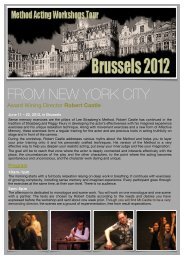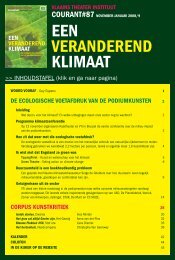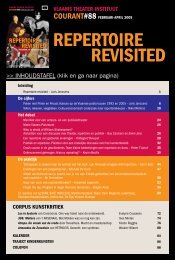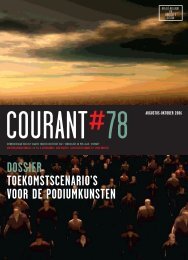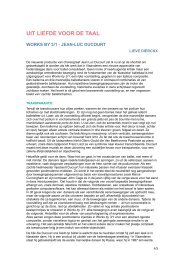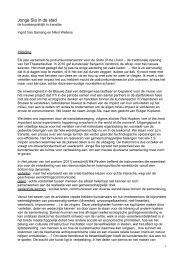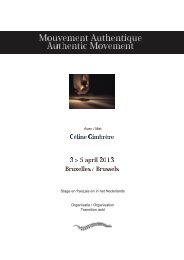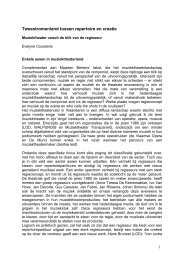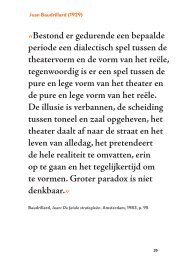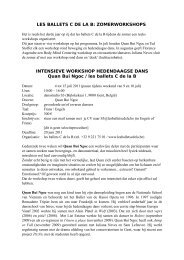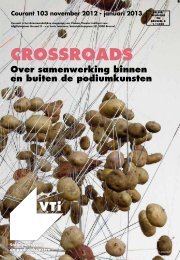music theatre in flanders - Muziekcentrum Vlaanderen
music theatre in flanders - Muziekcentrum Vlaanderen
music theatre in flanders - Muziekcentrum Vlaanderen
Create successful ePaper yourself
Turn your PDF publications into a flip-book with our unique Google optimized e-Paper software.
also <strong>in</strong>cludes organizations that received Flemish subsidies from<br />
outside the culture budget, or from other government bodies on<br />
different levels (federal, local or European). In some exceptional<br />
cases – for <strong>in</strong>stance the European Cultural Capitals (Brussels<br />
2000 and Bruges 2002), the governments acted as producers<br />
themselves. Music <strong>theatre</strong>’s major player is the Brussels based<br />
Royal Monnaie – an <strong>in</strong>stitute funded by the federal government.<br />
Another category that should not be underestimated is the<br />
cultural centres. These venues, which are ma<strong>in</strong>ly funded by municipalities,<br />
act as co-producers only exceptionally. For the exam<strong>in</strong>ed<br />
period, about 14 cultural centres were known to co-produce<br />
<strong>music</strong> <strong>theatre</strong> productions. Perform<strong>in</strong>g arts tra<strong>in</strong><strong>in</strong>g graduation<br />
projects also f<strong>in</strong>d their way to VTi’s database.<br />
Foreign<br />
‘Foreign organizations’ are perform<strong>in</strong>g arts organizations that<br />
have an office address outside Belgium. We shall make dist<strong>in</strong>ctions<br />
based on geographical criteria and discuss them more thoroughly<br />
later.<br />
‘non-subsidized’ rest category<br />
F<strong>in</strong>ally there is a ‘non-subsidized’ rest category. We do not monitor<br />
the commercial sector systematically. This category therefore<br />
mostly <strong>in</strong>cludes non-subsidized producers who do have connections<br />
with the subsidized circuit: either because they did receive<br />
subsidies dur<strong>in</strong>g other periods, or because their work has been<br />
co-produced by subsidized organizations. Organizations of other<br />
arts sectors are also <strong>in</strong>cluded <strong>in</strong> this category, notably <strong>music</strong><br />
ensembles such as the Beethoven Academy, Champ d’Action,<br />
Aka Moon, Galacticamendum, Ictus and Bl!ndman. (We already<br />
mentioned that these ensembles’ contribution is often billed as<br />
part of the ‘cast’ rather than as ‘co-producer’. In these cases, the<br />
orchestra’s contribution is not reflected <strong>in</strong> the table and diagram<br />
shown below.)<br />
The table shows how many organizations of the types listed<br />
above appear <strong>in</strong> the three subsidy terms, as well as the total<br />
number of production credits for each of these types. That will allow<br />
us to see which types of organizations made the largest contribution<br />
to the (<strong>in</strong>creas<strong>in</strong>g) <strong>music</strong> <strong>theatre</strong> production. The correspond<strong>in</strong>g<br />
diagram is based on the <strong>in</strong>formation about the number<br />
of credits.<br />
Diagram 4: Background production credits <strong>music</strong> <strong>theatre</strong><br />
26 27<br />
table of contents<br />
500<br />
400<br />
300<br />
200<br />
100<br />
0<br />
63<br />
132<br />
175<br />
30<br />
1993-1997 1997-2001 2001-2005<br />
foreign<br />
other public fund<strong>in</strong>g<br />
Perform<strong>in</strong>g Arts Decree<br />
non-subsidized<br />
145<br />
204<br />
265<br />
67<br />
318<br />
229<br />
459<br />
115




